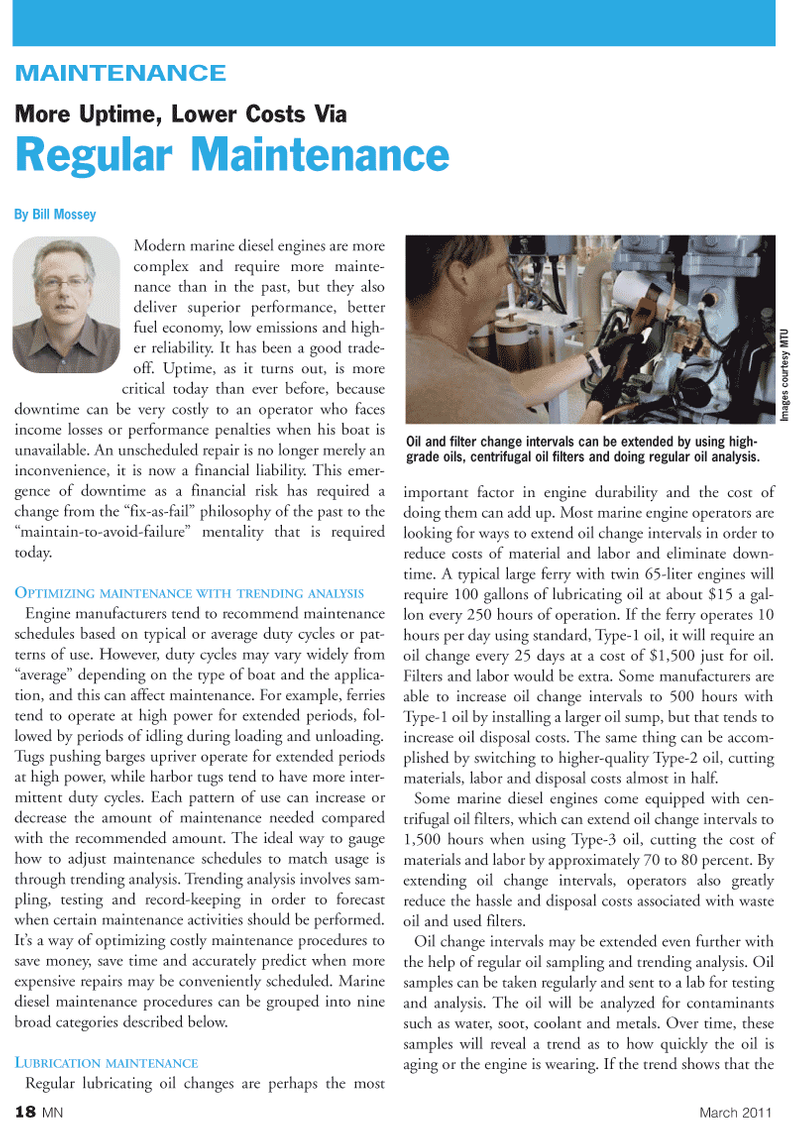
Page 18: of Marine News Magazine (March 2011)
Marine Training & Education Edition
Read this page in Pdf, Flash or Html5 edition of March 2011 Marine News Magazine
18 MN March 2011
MAINTENANCE
Modern marine diesel engines are more complex and require more mainte- nance than in the past, but they also deliver superior performance, better fuel economy, low emissions and high- er reliability. It has been a good trade- off. Uptime, as it turns out, is more critical today than ever before, because downtime can be very costly to an operator who faces income losses or performance penalties when his boat is unavailable. An unscheduled repair is no longer merely an inconvenience, it is now a financial liability. This emer- gence of downtime as a financial risk has required a change from the “fix-as-fail” philosophy of the past to the “maintain-to-avoid-failure” mentality that is required today.
OPTIMIZING MAINTENANCE WITH TRENDING ANALYSIS
Engine manufacturers tend to recommend maintenance schedules based on typical or average duty cycles or pat- terns of use. However, duty cycles may vary widely from “average” depending on the type of boat and the applica- tion, and this can affect maintenance. For example, ferries tend to operate at high power for extended periods, fol- lowed by periods of idling during loading and unloading.
Tugs pushing barges upriver operate for extended periods at high power, while harbor tugs tend to have more inter- mittent duty cycles. Each pattern of use can increase or decrease the amount of maintenance needed compared with the recommended amount. The ideal way to gauge how to adjust maintenance schedules to match usage is through trending analysis. Trending analysis involves sam- pling, testing and record-keeping in order to forecast when certain maintenance activities should be performed.
It’s a way of optimizing costly maintenance procedures to save money, save time and accurately predict when more expensive repairs may be conveniently scheduled. Marine diesel maintenance procedures can be grouped into nine broad categories described below.
LUBRICATION MAINTENANCE
Regular lubricating oil changes are perhaps the most important factor in engine durability and the cost of doing them can add up. Most marine engine operators are looking for ways to extend oil change intervals in order to reduce costs of material and labor and eliminate down- time. A typical large ferry with twin 65-liter engines will require 100 gallons of lubricating oil at about $15 a gal- lon every 250 hours of operation. If the ferry operates 10 hours per day using standard, Type-1 oil, it will require an oil change every 25 days at a cost of $1,500 just for oil.
Filters and labor would be extra. Some manufacturers are able to increase oil change intervals to 500 hours with
Type-1 oil by installing a larger oil sump, but that tends to increase oil disposal costs. The same thing can be accom- plished by switching to higher-quality Type-2 oil, cutting materials, labor and disposal costs almost in half.
Some marine diesel engines come equipped with cen- trifugal oil filters, which can extend oil change intervals to 1,500 hours when using Type-3 oil, cutting the cost of materials and labor by approximately 70 to 80 percent. By extending oil change intervals, operators also greatly reduce the hassle and disposal costs associated with waste oil and used filters.
Oil change intervals may be extended even further with the help of regular oil sampling and trending analysis. Oil samples can be taken regularly and sent to a lab for testing and analysis. The oil will be analyzed for contaminants such as water, soot, coolant and metals. Over time, these samples will reveal a trend as to how quickly the oil is aging or the engine is wearing. If the trend shows that the
More Uptime, Lower Costs Via
Regular Maintenance
By Bill Mossey
Oil and filter change intervals can be extended by using high- grade oils, centrifugal oil filters and doing regular oil analysis.
Images cour tesy MTU

 17
17

 19
19
